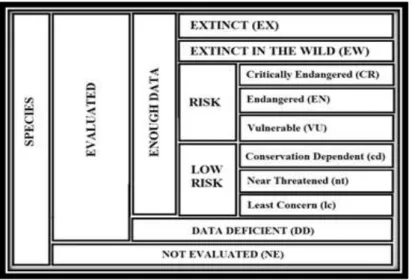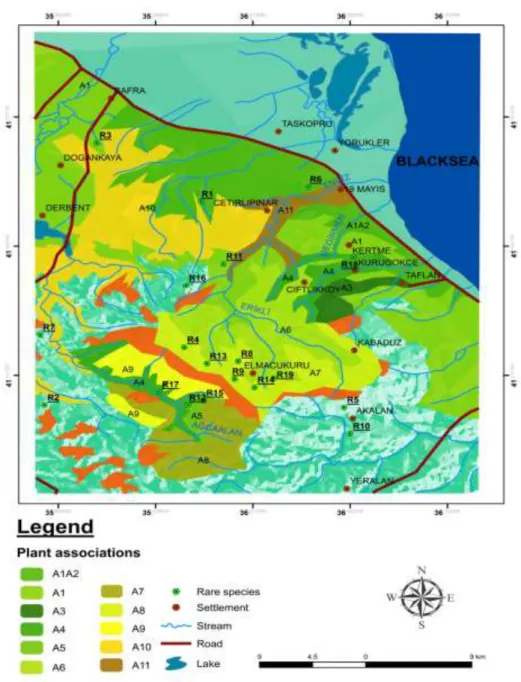www.biodicon.com Biological Diversity and Conservation
ISSN 1308-8084 Online; ISSN 1308-5301 Print
7/2 (2014) 73-77
Research article/Araştırma makalesi
The determination of rare species and risk categories in Nebyan Mountain (Samsun/Turkey)
Hamdi Güray KUTBAY
1, Burak SÜRMEN
*2, Dudu Duygu KILIÇ
3, Ali İMAMOĞLU
4 1Department of Biology, Faculty of Arts and Science, Ondokuz Mayıs University, Samsun, Turkey
2Department of Biology, Kamil Özdağ Science Faculty, Karamanoğlu Mehmetbey University, Karaman, Turkey
3
Department of Biology, Faculty of Arts and Science, Amasya University, Amasya, Turkey
4Department of Geography, Faculty of Arts and Science, Ondokuz Mayıs University, Samsun, Turkey
Abstract
In this study, we aimed to determine rare species in Nebyan Mountain (Samsun/TURKEY). Samsun province
has distinct ecological features because both oceanic and Mediterranean climate are seen. Therefore in the study area
different vegetation types namely temperate forest, scrub, grassland and stream valley vegetation types are found, and
Mediterranean enclaves constitute to the important part of the flora. 90 families, 331 genera and 611 species and taxa
were determined in the study area. 19 rare species are found according to Red Data Book of Turkish Plants (Ekim, et
al., 2000) and these taxa were evaluated according to the IUCN risk categories. The distribution of the threat categories
was as follows: 15 taxa in LR (ic), 1 taxa in LR (nt), 1 taxa in LR (cd), 1 taxa in EN, 1 taxa in VU.
Key words: Central Black Sea, Nebyan mount, rare species, IUCN, enclave, vegetation
---
---
Nebyan Dağı’nda (Samsun/TÜRKİYE) nadir türler ve risk kategorilerinin belirlenmesi
Özet
Bu çalışma Samsun ili Nebyan Dağı florasında bulunan nadir türlerin saptanması amacıyla gerçekleştirilmiştir.
Samsun ili ekolojik yönden çeşitli özelliklere sahiptir. Bu çeşitliliğin en önemli sebeplerinden biri Orta Karadeniz
Bölgesinde olmasına rağmen iklim özellikleri bakımından Akdeniz iklim tipine ait karakterlere sahip olmasıdır. Bu
nedenle araştırma alanında orman, maki, çayır ve nemli dere vejetasyon tiplerinin bulunmasının yanında, Akdeniz
enklavları da bulunmaktadır. Araştırmalar sonucunda çalışma alanında 90 familyaya ait 331 cins ve 611 tür ve tür altı
takson belirlenmiştir. Bölgede Türkiye Bitkileri Kırmızı Kitabı'na göre (Ekim, et al., 2000) 19 nadir tür belirlenmiş ve
bu taksonlar IUCN risk kategorilerine göre değerlendirilmiştir. Türkiye Bitkileri Kırmızı Kitabı’ndaki IUCN tehlike
kategorilerine göre araştırma alanında yayılış gösteren 611 taksonun, 15 adeti LR (ıc), 1 adeti LR (nt), 1 adeti LR (cd),
1 adeti EN, 1 adeti ise VU kategorisine dahildir.
Anahtar kelimeler: Orta Karadeniz, Nebyan dağı, nadir türler, IUCN, enklav, vejetasyon
1. Introduction
Turkey have three different floristic regions namely Euro-Siberian, Mediterranean and Irano-Turanien and
distinct attributes with respect to geographical location, geomorphological structure, and climate types. As a result of all
these features, Turkey is different from neighboring countries from botanical point of view. Turkey has a rich flora in
the temperature zone, with approximately 10,000 vascular plants (Sağıroğlu and Duman, 2011).
The study area (“Nebyan Mountain”), has oceanic climate. However, Mediterranean climate is also seen in
western part and especially along Kızılırmak valley. The study area is located in Euxine province of Euro-Siberian
floristic region. Furthermore, the vegetation of Nebyan Mountain appears to significant differences in terms of altitude,
*Corresponding author / Haberleşmeden sorumlu yazar: Tel.: +903623121919-5129; Fax.: +903623121919; E-mail: buraksurmen@gmail.com © 2008 All rights reserved / Tüm hakları saklıdır BioDiCon. 343-0713
aspect, topography, temperature and precipitation depending on the ecological and geographical factors. Therefore, the
study area have different vegetation types namely forest, maquis and stream valley vegetation (Kutbay and Kılınç,
1995a; Kutbay and Sürmen, 2013).
Nebyan Mountain is selected for this study because of having a particular flora and vegetation. The study area
include typical Euro-Siberian species and including many Mediterranean enclaves, has a great potential for eco-tourism,
road works and abiotic factors. However, the flora of the study area is subject to environmental damage due to tourism
activities, overgrazing, land use patterns and agricultural activities (Karaer, et al., 2011). Nowadays, Nebyan Mountain
has been visited by native and alien tourists for eco-tourism and other tourism activities, mountain tourism, photo-safari,
and etc. Owing to these reasons, endemic and rare plants in the area were determined and risk categories of these plants
were evaluated to contribute sustainable use of the area and develop protection strategies.
2. Materials and methods
The study area is located in A5-A6 squares according to the grid system of Davis and is called Nebyan Mountain
(Samsun/Bafra) (Figure 1). It is surrounded by rich water resources, the most important one is Kızılırmak. The oldest
geological structure unit is the upper cretaceous flysch series, volcanic and alluvial series are also present. The common
soil groups are brown forest soils; grey-brown podsolic soils, alluvial and colluvial series (Kutbay, et al., 1995b).
The vegetation of the study area has been classified and eleven plant associations have been determined
belonging to three vegetation types (Kutbay and Kılınç, 1995a; Kutbay and Sürmen, 2011). These associations and
vegetation types are given in fallowing Table 1.
Table 1. Vegetation types and plant associations. ("A" codes for associations)
Vegetation types Plant associationsMacquis vegetation Carpino orentalis - Phillyretum latifoliae Quézel et al., 1980 (A1)
Macquis vegetation Phillyreo latifolia - Lauretum nobilis Quézel et al., 1980 (A2)
Forest vegetation Carpino orientalis - Quercetum cerridis Kutbay & Kılınç 1995 (A3)
Forest vegetation Carpino orientalis - Fagetum orientalis Akman et al., 1983 (A4)
Forest vegetation Fago orientalis - Abietum nordmannianae Akman, 1976 (A5)
Forest vegetation Fago orientalis - Castanetum sativae Quézel et al., 1980 (A6)
Forest vegetation Rhododendro luteo - Fagetum orientalis Kutbay & Kılınç 1995 (A7)
Forest vegetation Daphno ponticae - Pinetum sylvestris Akman, 1974 (A8)
Forest vegetation Genisto tinctoriae - Pinetum nigrae Kutbay & Kılınç 1995 (A9)
Forest vegetation Querco infectoriae - Pinetum brutiae Kutbay & Kılınç 1995 (A10)
Moisture valley vegetations Salici albae - Platanetum orientalis Kutbay&Kılınç 1995 (A11)
The mean temperature of the coldest month (February) in the area is 6.9 °C, whereas the hottest month is
(August) has a mean daily temperature of 28.2 °C. The hottest month is November (38.4 °C), while the coldest month is
March (-7.0 °C). Mean annual precipitation is 691.70 mm. The study area is situated in Euxine province of
Euro-Siberian phytogeogaphical region. 1125 plant samples were collected in the study area. Plant taxa were determined
followed Davis et al. (1965-1985), Davis et al. (1988), Güner et al. (2000) and Kutbay et al. (1995b). The risk groups of
species were also determined according to IUCN categories (Figure 2). Moreover 155 sampling plots were taken, and
cover-abundance of species was estimated according to Braun-Blanquet vegetation classification method
(Mueller-Dumbois and Ellenberg, 1974).
Figure 1. Map of Nebyan Mount. "A" and "R" codes for plant associations and rare species, respectively
3. Results
In the study area, 611 species were identified belonging to 90 families and 331 genus. According to Red Data
Book of Turkish Plants (Ekim, et al., 2000), 19 rare species were identified and evaluated according to the IUCN
categories of risk. As a result 15 taxa in LR (ic), 1 taxa in LR (nt), 1 taxa in LR (cd), 1 taxa in EN, 1 taxa in VU
category (Table 2). Arum euxinum R. Mill has 1% cover-abundance in three sampling plots (Total sample plot
area=2700 m
2) and it is found in Fago orientalis - Castanetum sativae Quézel et al., 1980. Cirsium pseudopersonata
Boiss. & Bal. subsp. pseudopersonata has 1% cover-abundance in 13 sampling plots (Total sample plot area=11000 m
2)
and it is found in three plant associations. They are Carpino orientalis - Quercetum cerridis Kutbay & Kılınç 1995,
Carpino orientalis - Fagetum orientalis Akman et al., 1983, Fago orientalis - Abietum nordmannianae Akman, 1976,
Fago orientalis - Castanetum sativae Quézel et al., 1980. Cirsium poluninii Davis & Parris is only found in one
sampling plot (Total sample plot area=900 m
2) with 1% cover-abundance and it is found one plant association (Fago
orientalis - Castanetum sativae Quézel et al., 1980). Trifolium pannonicum Jacq. subsp. elongatum (Wild.) Zoh. has 3%
cover-abundance (Total sample plot area= 1200 m
2) and belonging to Carpino orentalis - Phillyretum latifoliae Quézel
et al., 1980 and Querco infectoriae - Pinetum brutiae Kutbay & Kılınç 1995 (Table 3). Other rare species are
represented by a single individual in different localities. The localities of rare species are given in table 4. All rare
species and plant associations are showed in figure 1.
Table 2. Risk categories of determined species in Nebyan Mount. ("R" codes for rare species)
Family Species IUCN red list
categories
Malvaceae Alcea apterocarpa (Fenzl) Boiss. (R1) LR(Ic)
Linaceae Linum flavum L. subsp. scabrinerve (Davis) Davis (R2) LR(Ic)
Geraniaceae Geranium asphodeloides Burm. Fil. Subsp. sintenisii (Freyn) Davis (R3) LR(Ic)
Geraniaceae Geranium cinereum Cav. subsp. subcaulescens (L’Herit. Ex DC.) Hayek var.
ponticum (R4) LR(Ic)
Fabaceae Genista aucheri Boiss. (R5) LR(Ic)
Fabaceae Lathyrus czeczottianus Bassler (R6) LR(Ic)
Fabaceae Trifolium pannonicum Jacq. subsp. elongatum (Wild.) Zoh. (R7) LR(Ic)
Asteraceae Cirsium poluninii Davis & Parris (R8) VU
Asteraceae Cirsium pseudopersonata Boiss. & Bal. Subsp. pseudopersonata (R9) LR(Ic)
Asteraceae Centaurea consanguinea DC. (R10) LR(Ic)
Asteraceae Hieracium lasiochaetum (Bornm. &Zahn) Sell& West (R11) LR(Ic)
Boraginaceae Symphytum bornmuelleri Bucknall (R12) LR(Ic)
Scrophulariaceae Veronica multifida L. (R13) LR(Ic)
Lamiaceae Lamium gundelsheimeri C. Koch (R14) LR(Ic)
Rubiaceae Galium margaceum Ehrend & Schönb (R15) LR(Ic)
Araceae Arum euxinum R. Mill (R16) LR(Ic)
Poaceae Festuca cyllenica Boıss. Et Heldr. subsp. uluana Markgr.-Dannenb. (R17) LR(nt)
Poaceae Festuca pontica (E. Alexeevex) Marlgr. Dannenb. (R18) EN
Poaceae Festuca paphlagonica Yves) Markgr.-Dannenb. subsp. paphlagonica
(St.-Yves) Markgr.-Dannenb. (R18) LR(cd)
Table 3. Population area size of selected rare species.
Approximate population area size
Arum euxinum R. 27 m2
Cirsium pseudopersonata Boiss. & Bal. subsp. pseudopersonata 110 m2
Cirsium poluninii Davis & Parris 9 m2
Trifolium pannonicum Jacq. subsp. elongatum (Wild.) Zoh. 36 m2
Table 4. General localite features of rare species.
Species Distribution areas altitude aspect
C. pseudopersonata ssp. pseudopersonata Taflan, Kertme, Beylik and Çetirlipınar villages
100-150m NW and E
Kurugökçe, Ağcaalan villages 450 m NE
Ağcaalan, Asmaçam villages 750-850m NE and E
Kurugökçe and Elmaçukuru villages 250-800 m N and NE
A. euxinum Kurugökçe and Elmaçukuru villages 250-800 m N, NE and E C. poluninii Kurugökçe and Elmaçukuru 700 m NE
T. pannonicum subsp. elongatum İnözükkoşaca, KızılırmaK valley 0-300 m N A. apterocarpa Bafra, Köseli villages 200 m - L. flavum subsp. scabrinerve Bafra, Ağcaalan villages 300 m - G. asphodeloides subsp. sintenisii Bafra, Aktekke villages 30 m - G. cinereum subsp. subcaulescens var.
ponticum
Bafra, Nebyan Mount 1200 m N
G. aucheri Merkez, Akalan villages 700 m -
L. czeczottianus 19 Mayıs, Fındıcak River 25 m - C. consanguinea Merkez Güney villages 650 m - H. lasiochaetum 19 Mayıs, Ormancık villages 200 m -
S. bornmuelleri Bafra, Nebyan Mount 1200 m N
V. multifida Bafra, Ağcaalan villages 350m - L. gundelsheimeri Merkez Elmaçukuru villages 750 m - G. margaceum Bafra, Ağcaalan villages 250 m - F. cyllenica subsp. uluana Bafra, Ağcaalan villages 300 m - F. pontica Merkez Kurugökçe villages 100 m - F. paphlagonica subsp. paphlagonica Merkez Elmaçukuru villages 800 m -

